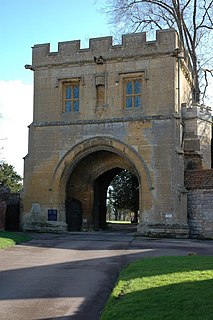 W
WAbbey Gatehouse is a gatehouse building to Tewkesbury Abbey, in Tewkesbury, Gloucestershire, England. It is a Grade I listed building.
 W
WThe Abbey Gateway is in Chester, Cheshire, England and leads from Northgate Street into Abbey Square. It is recorded in the National Heritage List for England as a designated Grade I listed building.
 W
WThe Abbey Gateway, St Albans was built in 1365 and is the last remaining building of the Benedictine Monastery at St Albans, Hertfordshire.
 W
WBalkerne Gate is a 1st-century Roman gateway in Colchester. It is the largest surviving gateway in Roman Britain and was built where the Roman road from Londinium intersected the town wall. It is a Grade I listed building.
 W
WCartmel Priory Gatehouse is a medieval building located at Cartmel, Grange-over-Sands, Cumbria, England. It is listed grade II* and is part of a scheduled monument. It belongs to the National Trust.
 W
WWright's Almshouses is a terrace of six former almshouses now located on Beam Street in Nantwich, Cheshire, England. The building was originally erected at the junction of Hospital Street and London Road in 1638 by Edmund Wright, Lord Mayor of London in 1640–41, and is listed at grade II*. The low red-brick terrace has stone dressings and a central stone panel with arms. The adjacent stone archway of 1667, which Nikolaus Pevsner describes as the "best" feature of the almshouses, is also listed separately at grade II*, together with its associated wall.
 W
WKaleyard Gate is a postern gate in Chester city walls, Cheshire, England. It is recorded in the National Heritage List for England as a designated Grade I listed building.
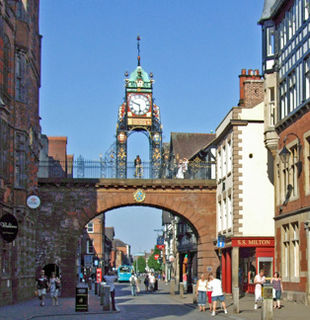 W
WEastgate and Eastgate Clock in Chester, Cheshire, England, stand on the site of the original entrance to the Roman fortress of Deva Victrix. It is a prominent landmark in the city of Chester and is said to be the most photographed clock in England after Big Ben.
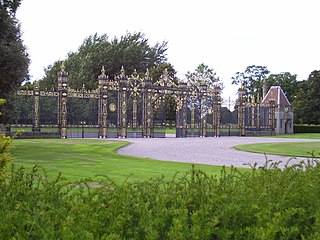 W
WThe Golden Gates at Eaton Hall, Cheshire, England, stand at the eastern end of Belgrave Avenue. The gates with their overthrow, the screens at their sides and the associated wing lodges are recorded in the National Heritage List for England as a designated Grade I listed building. The gates stand in front of what was formerly the principal entrance to the forecourt of the hall. The central pair of gates and the adjacent screen railings date from the early 18th century and are by Robert and John Davies of Croes Foel. The further side gates and screens, dating from around 1880, were designed by Alfred Waterhouse and made by Skidmore of Coventry. At the extremities is a pair of lodges, which are also dated around 1880, and by Alfred Waterhouse. The lodges are designed in a French Renaissance style. They are in one storey and have one room, with a sentry-box-like porch at the front. The roofs are steeply hipped, and at the eaves is a corbelled balustrade.
 W
WEccleston Hill Lodge is a gateway and lodge near the village of Eccleston, Cheshire, England. It stands at the entrance of the Chester Approach to the estate of Eaton Hall. The structure is recorded in the National Heritage List for England as a designated Grade II* listed building.
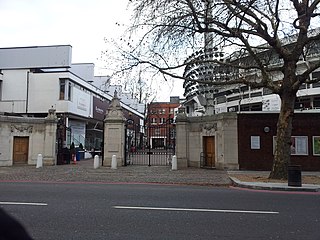 W
WThe Grace Gates, officially the W. G. Grace Memorial Gates, are two pairs of gates on St John's Wood Road at Lord's Cricket Ground in London, England. They were erected in 1923 and the gates with their flanking walls and piers became a Grade II listed building in 1996.
 W
WThe Great Gatehouse, also known as the Abbey Gatehouse, is a historic building on the south side of College Green in Bristol, England. Its earliest parts date back to around 1170. It was the gatehouse for St Augustine's Abbey, which was the precursor of Bristol Cathedral. The gatehouse stands to the cathedral's west, and to its own west it is abutted by the Bristol Central Library building. The library's architectural design incorporated many of the gatehouse's features.
 W
WKing James's and Landport Gates are two English Heritage gateways in Portsmouth, Hampshire, England.
 W
WKingswood Abbey was a Cistercian abbey, located in the village of Kingswood near Wotton-under-Edge, Gloucestershire, England. The abbey was demolished during the Dissolution of the Monasteries, and all that remains is the gatehouse, a Grade 1 listed building. Through the gatehouse arch are a few houses and the small village primary school of Kingswood.
 W
WThe Malvern Museum in Great Malvern, the town centre of Malvern, Worcestershire, England, is located in the Priory Gatehouse, the former gateway to the Great Malvern Priory. The museum was established in 1979 and is owned and managed by the Malvern Museum Society Ltd, a registered charity. The Priory Gatehouse was a gift to the museum in 1980 from the de Vere Group, the owners of the neighbouring Abbey Hotel, and is staffed by volunteers. As such, the building itself is the museum's major exhibit.
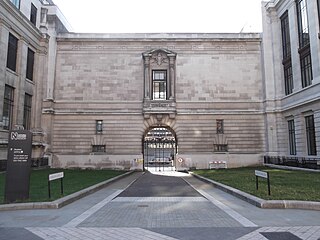 W
WMuseum Lane runs between two of London's leading museums in South Kensington, namely the Science Museum to the north and the Natural History Museum to the south. It runs to the west off Exhibition Road through a gateway connecting the two museums and connects with Queen's Gate. Opposite on Exhibition Road is the Henry Cole Wing of the Victoria and Albert Museum. The Dana Centre is just to the north at the Queen's Gate end.
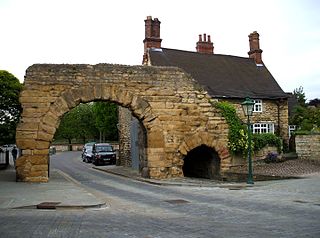 W
WNewport Arch is a 3rd-century Roman gate in the city of Lincoln, Lincolnshire. It is a Scheduled monument and Grade I listed building and is reputedly the oldest arch in the United Kingdom still used by traffic.
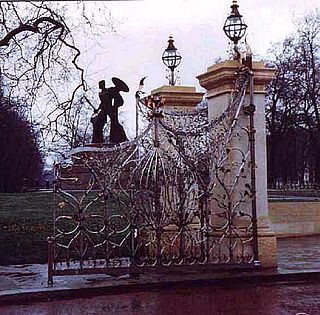 W
WQueen Elizabeth Gate, also known as the Queen Mother's Gate, is an entrance consisting of two pairs and two single gates of forged stainless steel and bronze situated in Hyde Park, London, behind Apsley House at Hyde Park Corner. There is also a centre feature made of painted cast iron.
 W
WRamsey Abbey Gatehouse was the gatehouse to the Benedictine Ramsey Abbey in Ramsey, Huntingdonshire, England. The gatehouse is Perpendicular Gothic and was built late in the 15th century.
 W
WReading Abbey is a large, ruined abbey in the centre of the town of Reading, in the English county of Berkshire. It was founded by Henry I in 1121 "for the salvation of my soul, and the souls of King William, my father, and of King William, my brother, and Queen Maud, my wife, and all my ancestors and successors." In its heyday the abbey was one of Europe's largest royal monasteries. The traditions of the Abbey are continued today by the neighbouring St James's Church, which is partly built using stones of the Abbey ruins.
 W
WStoneleigh Abbey Gatehouse is the 14th century gatehouse to the medieval Stoneleigh Abbey which was established near Stoneleigh, Warwickshire in the 12th century. It is a Grade I listed building.
 W
WA Tapsel gate is a type of wooden gate, unique to the English county of Sussex, which has a central pivot upon which it can rotate through 90° in either direction before coming to a stop at two fixed points. It was named after a Sussex family of bell-founders, one of whom invented it in the late 18th century. Only six examples survive, all within a 10-mile (16 km) radius of Lewes, the county town of Sussex. Tapsel gates have the dual advantage of keeping cattle out of churchyards and allowing the efficient passage of coffins carried to and from the church during burials. The name sometimes is used more generally to describe swivelling gates of a similar design elsewhere.
 W
WThornton Abbey was a medieval abbey located close to the small North Lincolnshire village of Thornton Curtis, near Ulceby, and directly south of Hull on the other side of the Humber estuary. Its ruins are a Grade I listed building, including notably England's largest and most impressive surviving monastic gatehouse.
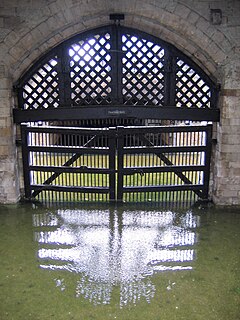 W
WThe Traitors' Gate is an entrance through which many prisoners of the Tudors arrived at the Tower of London. The gate was built by Edward I, to provide a water gate entrance to the Tower, part of St. Thomas's Tower, which was designed to provide additional accommodation for the royal family.
 W
WWestbury College Gatehouse is a 15th-century gatehouse to the 13th-century College of Priests located in Westbury-on-Trym, Bristol, England, and now a National Trust property.
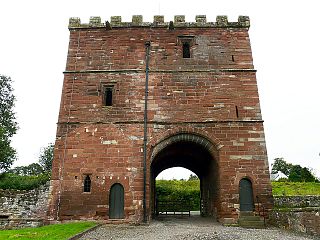 W
WWetheral Priory Gatehouse is a 15th-century stone fortification in Wetheral, Cumbria. The priory was founded at the start of the 12th century and the gatehouse controlled the entrance to its outer courtyard. When the priory was dissolved in 1538 the gatehouse and a nearby stretch of wall were the only parts to survive. The gatehouse passed into the control of Carlisle Cathedral and became the local vicarage during the 16th and 17th centuries, before being used to store hay. Now part of a modern farm that occupies the former priory site, it is controlled by English Heritage and open to visitors. The crenellated gatehouse has three storeys, with the main entrance and porters' lodge on the ground floor and two domestic chambers on the upper floors. English Heritage considers the building to be "the finest medieval gatehouse in Cumbria".